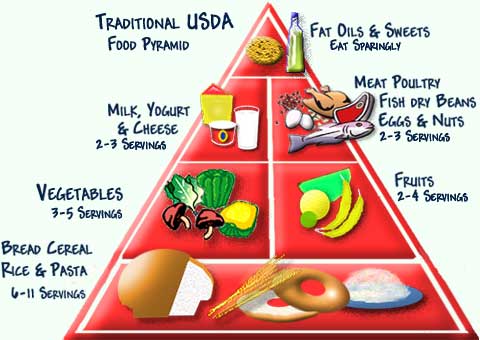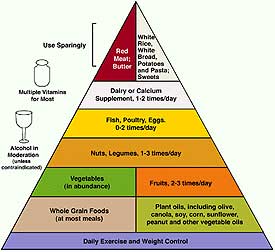This guest column by Jameson Rourke inaugurates our new section featuring essays and work by guest editors, writers, photographers and artists. If you would like to submit your work for publication please send it to Editor, The Green Cutting Board.
April 10,2004
In 1992 the USDA introduced the "Food Pyramid" a graphic representation of the basic food groups and their relative portioning in the course of a "healthy" human diet. The pyramid is a clear visual representation, easily reproduced and distributed by various media for use in public information campaigns, schools, and libraries. It was a brilliant marketing concept created and precisely executed by The Department of Agriculture and it was wrong! Wrong for two reasons; the Department of Agriculture has no mandate to develop a diet recommendation and their research efforts were minimal at best. As portrayed, the food groups are misrepresented within the pyramid that mixes red meat, fish and dry beans in one category while sugar and oil are paired in another. The structure ignores proportional attributes in serving sizes and frequency and suggests with one very broad stroke that fat is 'bad" and all carbohydrates are "good." The 13 year old USDA Food Pyramid doesn't even allow for the different nutritional requirements of children and adults or men and women.
The Department of Agriculture today, as at its beginning, is responsible for promoting US agricultural interests overseas; working to insure that American farmers have fair access to foreign markets. The USDA is not required to conduct research on or to recommend dietary guidelines, this is something called institutional creep, generally systemic among agencies of the Federal Government. The result of all this is that Americans today are beset by a bewildering array of conflicted dietary recommendations and a market place flooded with questionable franken-food. The Fast food industry has misused the flawed "Food Pyramid" to promote their products as healthy by claiming strict adherence to the standards set forth in the ubiquitous food graphic. The result of all this is that America today suffers an appalling epidemic of obesity with its consequent health care impact and at the same time an endemic rate of malnutrition.
Generations of adults brought up on family farms, home cooking and within the government school cafeteria programs of the fifties, sixties and seventies can only watch perplexed as the rate of obesity has surged among young adults and children of the 80s and 90s. According to the Center for Disease Control and Prevention website the percentage of Americans suffering from obesity rose in the United States between 1991 from 12 % to almost 21% in 2001; a staggering 75% increase since publication of the USDA Food Pyramid. It would be wrong of course to draw a direct cause and effect between this statistic and the publication of a simple graphic but such is the power of advertising where a picture is "worth a thousand words" and, when backed by the authority of the United States Government, the result can have a significant impact on public policy.

Traditional USDA Food Pyramid
Source: GCBPress, 2004
Among other things you will probably notice the grouping of meat, poultry, fish, dry beans, eggs and nuts, all great sources of protein but hardly related as to food type. Meat, generally typified, as "red" meat shares an upper quadrant along with eggs and poultry. Fish are here as well however no mention is made of its rich concentration of omega oils, nuts are included and finally beans. The last two certainly do not belong in the grouping.
Many recent revisions to the traditional pyramid have been proposed, most notably by Oldways Preservation & Exchange Trust a non-profit founded in 1988 to promote healthy eating and encourage sustainable food choices. Oldways has several alternative food pyramids: Mediterranean Diet, Latin Diet, Oriental Diet and Vegetarian. The Harvard School of Public Health has developed a Healthy-Eating Pyramid. All of these recent interpretations of the food pyramid purport to be based on scientific nutritional analysis of factors in diet that include among other things, gender, age, physical activity and even geographical and cultural influences; for instance the Mediterranean Diet emphasizes a tradition of locally and seasonally available produce rather than food imported from other regions and climates.

Vegetarian Pyramid
Source: Loma Linda University

Healthy-Eating Pyramid
Source: Harvard School of Public Health
In 2001 the USDA began to rethink its original approach to the decade old Food Pyramid and on their website invited comment from the public at large in order to revision the graphic and make it a more useful tool. The agency claims the process is an open, ongoing one and may result in multiple configurations of the food pyramid in order to best serve the wide variety of individual life styles and tastes. The agricultural industry, grocers, food service businesses and institutional food venues in the United States could well profit by observing these trends and acting to facilitate consumer demand rather than trying to influence the process to further their own agenda, they could, it remains to be seen if they will.
J. Rourke is a freelance writer who reports on science, health issues and public policy.
April 10,2004
USDA Food Pyramid Reexamined
By Jameson Rourke
In 1992 the USDA introduced the "Food Pyramid" a graphic representation of the basic food groups and their relative portioning in the course of a "healthy" human diet. The pyramid is a clear visual representation, easily reproduced and distributed by various media for use in public information campaigns, schools, and libraries. It was a brilliant marketing concept created and precisely executed by The Department of Agriculture and it was wrong! Wrong for two reasons; the Department of Agriculture has no mandate to develop a diet recommendation and their research efforts were minimal at best. As portrayed, the food groups are misrepresented within the pyramid that mixes red meat, fish and dry beans in one category while sugar and oil are paired in another. The structure ignores proportional attributes in serving sizes and frequency and suggests with one very broad stroke that fat is 'bad" and all carbohydrates are "good." The 13 year old USDA Food Pyramid doesn't even allow for the different nutritional requirements of children and adults or men and women.
The Department of Agriculture today, as at its beginning, is responsible for promoting US agricultural interests overseas; working to insure that American farmers have fair access to foreign markets. The USDA is not required to conduct research on or to recommend dietary guidelines, this is something called institutional creep, generally systemic among agencies of the Federal Government. The result of all this is that Americans today are beset by a bewildering array of conflicted dietary recommendations and a market place flooded with questionable franken-food. The Fast food industry has misused the flawed "Food Pyramid" to promote their products as healthy by claiming strict adherence to the standards set forth in the ubiquitous food graphic. The result of all this is that America today suffers an appalling epidemic of obesity with its consequent health care impact and at the same time an endemic rate of malnutrition.
Generations of adults brought up on family farms, home cooking and within the government school cafeteria programs of the fifties, sixties and seventies can only watch perplexed as the rate of obesity has surged among young adults and children of the 80s and 90s. According to the Center for Disease Control and Prevention website the percentage of Americans suffering from obesity rose in the United States between 1991 from 12 % to almost 21% in 2001; a staggering 75% increase since publication of the USDA Food Pyramid. It would be wrong of course to draw a direct cause and effect between this statistic and the publication of a simple graphic but such is the power of advertising where a picture is "worth a thousand words" and, when backed by the authority of the United States Government, the result can have a significant impact on public policy.

Traditional USDA Food Pyramid
Source: GCBPress, 2004
Among other things you will probably notice the grouping of meat, poultry, fish, dry beans, eggs and nuts, all great sources of protein but hardly related as to food type. Meat, generally typified, as "red" meat shares an upper quadrant along with eggs and poultry. Fish are here as well however no mention is made of its rich concentration of omega oils, nuts are included and finally beans. The last two certainly do not belong in the grouping.
Many recent revisions to the traditional pyramid have been proposed, most notably by Oldways Preservation & Exchange Trust a non-profit founded in 1988 to promote healthy eating and encourage sustainable food choices. Oldways has several alternative food pyramids: Mediterranean Diet, Latin Diet, Oriental Diet and Vegetarian. The Harvard School of Public Health has developed a Healthy-Eating Pyramid. All of these recent interpretations of the food pyramid purport to be based on scientific nutritional analysis of factors in diet that include among other things, gender, age, physical activity and even geographical and cultural influences; for instance the Mediterranean Diet emphasizes a tradition of locally and seasonally available produce rather than food imported from other regions and climates.

Vegetarian Pyramid
Source: Loma Linda University

Healthy-Eating Pyramid
Source: Harvard School of Public Health
In 2001 the USDA began to rethink its original approach to the decade old Food Pyramid and on their website invited comment from the public at large in order to revision the graphic and make it a more useful tool. The agency claims the process is an open, ongoing one and may result in multiple configurations of the food pyramid in order to best serve the wide variety of individual life styles and tastes. The agricultural industry, grocers, food service businesses and institutional food venues in the United States could well profit by observing these trends and acting to facilitate consumer demand rather than trying to influence the process to further their own agenda, they could, it remains to be seen if they will.
J. Rourke is a freelance writer who reports on science, health issues and public policy.
